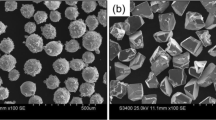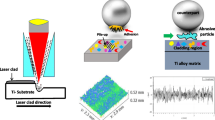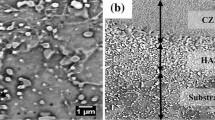Abstract
In this paper, in order to improve microhardness and wear resistance of grinding layers for metal-bonded laser cladding grinding tools, the integrity of CBN grits during laser cladding process is protected and bonding quality between metal matrix and CBN grits is improved. 0%, 1.25%, 2.5%, 3.75%, and 5% of B4C as additive for CBN/CuSnTi laser cladding layers were conducted. The surface morphology of these laser cladding layers was observed. The elements distribution and species of phases in cross section of these laser cladding layers were analyzed by scanning electron microscopy (SEM)/energy dispersive spectrometer (EDS) and X-ray diffractometer (XRD), and reaction mechanism was analyzed by Gibbs free energy theory. The microhardness and wear resistance of these laser cladding layers were tested. Then, grinding tests with 0%, 2.5%, and 5% B4C added CBN/CuSnTi LCGTs were conducted. The results show that no cracks and intact CBN cutting edges were on laser cladding layer when 5% B4C was added. The mechanical quality involved microhardness and wear resistance of 5% B4C added laser cladding layer were better than that of other B4C contents of laser cladding layers. The surface roughness of 5% added LCGT is the best. 5% B4C can be the additive for CBN/CuSnTi LCGT.














Similar content being viewed by others
Availability of data and material
The authors declare that the data and material supporting the findings of this work are available within the article.
References
Mao C, Zhong Y, Hu Y, Luo Y, Tang W, Bi ZM, Lei Z, Jiang C, Tang A (2021) Tensile behaviors of laser-discrete-quenched substrate/nickel coating of electroplated grinding wheel. Int J Pr Eng Man-Gt (article in press). https://doi.org/10.1007/s40684-021-00378-9
Mao C, Cai P, Hu Y, Zhong Y, Wei J, Bi Z, Jiang Y, Xiao L, Zhang M (2021) Effect of laser-discrete-quenching on bonding properties of electroplated grinding wheel with AISI 1045 steel substrate and nickel bond. Chinese J Aeronaut 34(6):79–89. https://doi.org/10.1016/j.cja.2020.09.010
Ding W, Xu J, Chen Z, Su H, Fu Y (2010) Grindability and surface integrity of cast nickel-based superalloy in creep feed grinding with brazed CBN abrasive wheels. Chinese J Aeronaut 23(4):501–510. https://doi.org/10.1016/S1000-9361(09)60247-8
Cao Y, Zhu Y, Ding W, Qiu Y, Wang L, Xu J (2021) Vibration coupling effects and machining behavior of ultrasonic vibration plate device for creep-feed grinding of Inconel 718 nickel-based superalloy. Chinese J Aeronaut (article in press). https://doi.org/10.1016/j.cja.2020.12.039
Ding W, Zhao B, Zhang Q, Fu Y (2021) Fabrication and wear characteristics of open-porous cBN abrasive wheels in grinding of Ti–6Al–4V alloys. Wear 477:203786. https://doi.org/10.1016/j.wear.2021.203786
Zhao B, Ding W, Xiao G, Zhao J, Li Z (2021) Effects of open pores on grinding performance of porous metal-bonded aggregated cBN wheels during grinding Ti–6Al–4V alloys. Ceram Int 47(22):31311–31318. https://doi.org/10.1016/j.ceramint.2021.08.004
Zhao B, Ding W, Xiao G, Zhao J, Li Z (2021) Self-sharpening property of porous metal-bonded aggregated cBN wheels during the grinding of Ti–6Al–4V alloys. Ceram Int (article in press). https://doi.org/10.1016/j.ceramint.2021.09.250
Mao C, Lu J, Zhao Z, Yin L, Hu Y, Bi Z (2018) Simulation and experiment of cutting characteristics for single cBN-WC-10Co fiber. Precis Eng 52:170–182. https://doi.org/10.1016/j.precisioneng.2017.12.001
Xiao H, Xiao B, Wu H, Xiao B, Yan X, Liu S (2019) Microstructure and mechanical properties of vacuum brazed CBN abrasive segments with tungsten carbide reinforced Cu–Sn–Ti alloys. Ceram Int 45(9):12469–12475. https://doi.org/10.1016/j.ceramint.2019.03.181
Mao C, Ren YH, Gan HY, Zhang MJ, Zhang J, Tang K (2015) Microstructure and mechanical properties of cBN-WC-Co composites used for cutting tools. Int J Adv Manuf Technol 76(9):2043–2049. https://doi.org/10.1007/s00170-014-6410-6
Miao Q, Ding W, Zhu Y, Chen Z, Fu Y (2016) Brazing of CBN grains with Ag-Cu-Ti/TiX composite filler - the effect of TiX particles on microstructure and strength of bonding layer. Mater Design 98:243–253. https://doi.org/10.1016/j.matdes.2016.03.033
Denkena B, Grove T, Bremer I, Behrens L (2016) Design of bronze-bonded grinding wheel properties. CIRP Ann 65(1):333–336. https://doi.org/10.1016/j.cirp.2016.04.096
Miao Q, Ding W, Fu D, Chen Z, Fu Y (2017) Influence of graphite addition on bonding properties of abrasive layer of metal-bonded CBN wheel. Int J Adv Manuf Technol 93:2675–2684. https://doi.org/10.1007/s00170-017-0714-2
Suri A, Subramanian C, Sonber J, Murthy T (2010) Synthesis and consolidation of boron carbide: a review. Int Mater Rev 55(1):4–40. https://doi.org/10.1179/095066009X12506721665211
Domnich V, Reynaud S, Haber R, Chhowalla M (2011) Boron carbide: structure, properties, and stability under Stress. J Am Ceram Soc 94(11):3605–3628. https://doi.org/10.1111/j.1551-2916.2011.04865.x
Meng X, Min J, Sun Z, Zhang W, Chang H, Han Y (2021) Columnar to equiaxed grain transition of laser deposited Ti6Al4V using nano-sized B4C particles. Compos B Eng 212:108667. https://doi.org/10.1016/j.compositesb.2021.108667
Tijo D, Masanta M (2019) Effect of Ti/B4C ratio on the microstructure and mechanical characteristics of TIG cladded TiC-TiB2 coating on Ti-6Al-4V alloy. J Mater Process Tech 266:184–197. https://doi.org/10.1016/j.jmatprotec.2018.11.005
Tijo D, Masanta M, Das A (2018) In-situ TiC-TiB2 coating on Ti-6Al-4V alloy by tungsten inert gas (TIG) cladding method: Part-I. Microstructure evolution Surf coat tech 344:541–552. https://doi.org/10.1016/j.surfcoat.2018.03.082
Tijo D, Masanta M (2018) In-situ TiC-TiB2 coating on Ti-6Al-4V alloy by tungsten inert gas (TIG) cladding method: Part-II. Mechanical performance Surf coat tech 344:579–589. https://doi.org/10.1016/j.surfcoat.2018.03.083
Gupta A, Hussain M, Misra S, Das A, Mandal A (2018) Processing and characterization of laser sintered hybrid B4C/cBN reinforced Ti-based metal matrix composite. Opt Laser Eng 105:159–172. https://doi.org/10.1016/j.optlaseng.2018.01.015
Yang F, Qin Q, Shi T, Chen C, Guo Z (2019) Surface strengthening aluminum alloy by in-situ TiC-TiB2 composite coating. Ceram Int 45(4):4243–4252. https://doi.org/10.1016/j.ceramint.2018.11.096
Tao X, Yao Z, Zhang S, Liao J, Liang J (2018) Investigation on microstructure, mechanical and tribological properties of in-situ (TiB + TiC)/Ti composite during the electron beam surface melting. Surf coat tech 337:418–425. https://doi.org/10.1016/j.surfcoat.2018.01.054
Mul D, Krivezhenko D, Zimoglyadova T, Popelyukh A, Lazurenko D, Shevtsova L (2015) Surface hardening of steel by electron-beam cladding of Ti+C and Ti+B4C powder compositions at air atmosphere. AMM 788:241–245. https://doi.org/10.4028/www.scientific.net/AMM.788.241
Bai L, Li J, Chen J, Song R, Shao J, Qu C (2016) Effect of the content of B4C on microstructural evolution and wear behaviors of the laser-clad coatings fabricated on Ti6Al4V. Opt Laser technol 76:33–45. https://doi.org/10.1016/j.optlastec.2015.07.010
Chen C, Feng X, Shen Y (2017) Synthesis of Al–B4C composite coating on Ti–6Al–4V alloy substrate by mechanical alloying method. Surf coat tech 321:8–18. https://doi.org/10.1016/j.surfcoat.2017.04.042
Li Z, Wei M, Xiao K, Bai Z, Xue W, Dong C, Wei D, Li X (2019) Microhardness and wear resistance of Al2O3-TiB2-TiC ceramic coatings on carbon steel fabricated by laser cladding. Ceram Int 45(1):115–121. https://doi.org/10.1016/j.ceramint.2018.09.140
Ochonogor O, Akinlabi E, Nyembwe D (2016) Effect of laser power on the microstructure and microhardness property of hybrid fabricated Ti6Al4V based metal matrix composite. WCE 2016 2:982–985. http://www.iaeng.org/publication/WCE2016/WCE2016_pp982-985.pdf
Wu C, Li Y, Xie S (2018) Micro-structure, mechanical properties and comparison of monolithic and laminated Ti-B4C composite with Al doped. J Alloy Compd 733:1–7. https://doi.org/10.1016/j.jallcom.2017.10.270
Fu F, Zhang Y, Chang G, Dai J (2016) Analysis on the physical mechanism of laser cladding crack and its influence factors. Optik 127(1):200–202. https://doi.org/10.1016/j.ijleo.2015.10.043
Jackson R (2000) Thermochemical data of elements and compounds. Weinheim, Germany. https://doi.org/10.1002/9783527619818
Miao Q, Ding W, Zhu Y, Chen Z, Xu J, Yang C (2016) Joining interface and compressive strength of brazed cubic boron nitride grains with Ag-Cu-Ti/TiX composite fillers. Ceram Int 42(12):13723–13737. https://doi.org/10.1016/j.ceramint.2016.05.171
Funding
This research was financially supported by The National Key Research and Development Program of China (No. 2020YFB2010500).
Author information
Authors and Affiliations
Contributions
Xufeng Zhao: research grinding and precession machining. Changhe Li: research grinding and precession machining, high-speed and ultra-high-speed machining, and digitalized manufacturing. Tianbiao Yu: research grinding and precession machining, digital design and intelligent manufacturing, additive manufacturing, and 3D printing and green remanufacturing.
Corresponding author
Ethics declarations
Ethics approval
Not applicable.
Consent to participate
Not applicable.
Consent for publication
Not applicable.
Conflict of interest
Not applicable.
Additional information
Publisher's Note
Springer Nature remains neutral with regard to jurisdictional claims in published maps and institutional affiliations.
Rights and permissions
About this article
Cite this article
Zhao, X., Li, C. & Yu, T. Effect of B4C on CBN/CuSnTi laser cladding grinding tool. Int J Adv Manuf Technol 119, 6307–6319 (2022). https://doi.org/10.1007/s00170-021-08460-x
Received:
Accepted:
Published:
Issue Date:
DOI: https://doi.org/10.1007/s00170-021-08460-x




